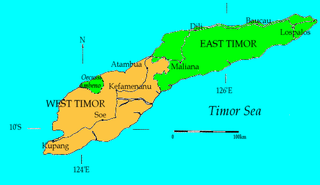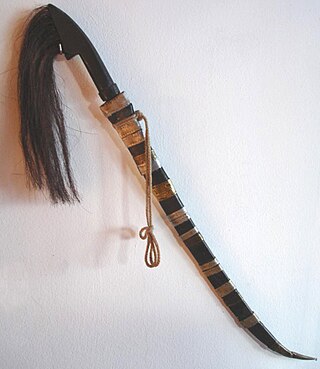Related Research Articles

Lombok is an island in West Nusa Tenggara province, Indonesia. It forms part of the chain of the Lesser Sunda Islands, with the Lombok Strait separating it from Bali to the west and the Alas Strait between it and Sumbawa to the east. It is roughly circular, with a "tail" to the southwest, about 70 kilometres across and a total area of about 4,738.65 square kilometres including smaller offshore islands. The provincial capital and largest city on the island is Mataram.

Sumbawa is an Indonesian island, located in the middle of the Lesser Sunda Islands chain, with Lombok to the west, Flores to the east, and Sumba further to the southeast. Along with Lombok, it forms the province of West Nusa Tenggara, but there have been plans by the Indonesian government to split the island off into a separate province. Traditionally, the island is known as the source of sappanwood, as well as honey and sandalwood. Its savanna-like climate and vast grasslands are used to breed horses and cattle, as well as to hunt deer.

West Timor is an area covering the western part of the island of Timor, except for the district of Oecussi-Ambeno. Administratively, West Timor is part of East Nusa Tenggara Province, Indonesia. The capital as well as its main port is Kupang. During the colonial period, the area was named Dutch Timor and was a centre of Dutch loyalists during the Indonesian National Revolution (1945–1949). From 1949 to 1975 it was named Indonesian Timor.

East Nusa Tenggara is the southernmost province of Indonesia. It comprises the eastern portion of the Lesser Sunda Islands, facing the Indian Ocean in the south and the Flores Sea in the north. It consists of more than 500 islands, with the largest ones being Sumba, Flores, and the western part of Timor; the latter shares a land border with the separate nation of East Timor. The province is subdivided into twenty-one regencies and the regency-level city of Kupang, which is the capital and largest city.

West Nusa Tenggara is a province of Indonesia. It comprises the western portion of the Lesser Sunda Islands, with the exception of Bali which is its own province. Mataram, on Lombok, is the capital and largest city of the province. It shares maritime borders with Bali to the west and East Nusa Tenggara to the east. The 2010 census recorded the population at 4,500,212; the total rose to 4,830,118 at the 2015 census and 5,320,092 at the 2020 census; the official estimate as at mid 2022 was 5,473,671. The province's area is 20,153.15 km2. The two largest islands by far in the province are Lombok in the west and the larger Sumbawa island in the east.

The Atoni people are an ethnic group on Timor, in Indonesian West Timor and the East Timorese enclave of Oecussi-Ambeno. They number around 844,030. Their language is Uab Meto.

El Tari International Airport, formerly Penfui Airport, is an airport in Kupang, East Nusa Tenggara, Indonesia. The airport is named after El Tari (1926–1978), the governor of East Nusa Tenggara from 1966 to 1978. The airport's ICAO code was changed from WRKK to WATT in 2004. As of December 2018, there were at least 258 outbound flights per week from the airport.
Abui is a non-Austronesian language of the Alor Archipelago. It is spoken in the central part of Alor Island in Eastern Indonesia, East Nusa Tenggara (NTT) province by the Abui people. The native name in the Takalelang dialect is Abui tanga which literally translates as 'mountain language'.

The Alor–Pantar languages are a family of clearly related Papuan languages spoken on islands of the Alor archipelago near Timor in southern Indonesia. They may be most closely related to the Papuan languages of eastern Timor, but this is not yet clear. A more distant relationship with the Trans–New Guinea languages of the Bomberai peninsula of Western New Guinea has been proposed based on pronominal evidence, but though often cited has never been firmly established.

Ngada Regency is one of the regencies on the island of Flores, East Nusa Tenggara Province, Indonesia. It is bordered by East Manggarai Regency to the west and Nagekeo Regency to the east, with the Flores Sea to the north and the Sawu Sea to the south. The Regency, which covers an area of 1,620.92 km2, had a population of 142,254 at the 2010 census, which increased to 165,254 at the 2020 census; the official estimate as at mid 2022 was 170,120. The town of Bajawa is the capital of Ngada Regency.

East Lombok Regency is a regency of the Indonesian Province of West Nusa Tenggara. It is located on the island of Lombok, of which it comprises the eastern third ; the administrative capital is the town of Selong. The Regency covers an area of 1,605.55 km2 and had a population of 1,105,582 at the 2010 Census and 1,325,240 at the 2020 Census; the official estimate as at mid 2022 was 1,366,434.

Rumah adat are traditional houses built in any of the vernacular architecture styles of Indonesia, collectively belonging to the Austronesian architecture. The traditional houses and settlements of the several hundreds ethnic groups of Indonesia are extremely varied and all have their own specific history. It is the Indonesian variants of the whole Austronesian architecture found all over places where Austronesian people inhabited from the Pacific to Madagascar each having their own history, culture and style.

The Manggarai language is the language of the Manggarai people from the western parts of the island of Flores, in East Nusa Tenggara Province, Indonesia.
The country of Indonesia consists of more than 17,000 islands and hundreds of different cultures. Each region has its own traditional costume. One of the unique traditional costumes worn in Bali, East Nusa Tenggara (NTT) and the West Nusa Tenggara (NTB) islands located in the eastern region of Indonesia. The three areas were once a single province known as a Lesser Sunda. Bali Nusra is a short form of Bali Nusa Tenggara Islands or Lesser Sunda Islands. And Tangi is a place in NTT.

The Lamahalot or Solorese people are an indigenous tribe located on Flores Island, Indonesia, and some smaller islands around it. Lamaholot people speak the Lamaholot language with different dialects, the number of speakers counts between 150,000 and 200,000.

Se'i or sei is an Indonesian smoked meat from Kupang, Timor island, East Nusa Tenggara, Indonesia. Se'i may be derived from a variety of meats, with pork, beef or game animals such as venison as common offerings. Today, the most popular se'i meat is pork.

The surik is a traditional sword native to the island of Timor or Nusa Tenggara in wider extent, as well as Sumatra. The first coat of arms of East Timor depicted crossed suriks.

The Muna or Wuna are an indigenous group that inhabits Muna Island, Southeast Sulawesi, Indonesia. From the physical appearance of the body, skull, skin color, and hair it appears that the aboriginal Muna people are closer to the ethnic groups of Polynesians and Melanesians in the Pacific and Aboriginal Australians compared to the Buginese or Malays. This is evident by the similarities of the people and their culture with of those in the East Nusa Tenggara, and the islands of Timor and Flores generally. Woven sarong motifs found in East Nusa Tenggara and Muna Island share similar features such as horizontal lines with basic colors of yellow, green, red, and black. The shape of their headwear also has a resemblance to each other. Since before until today, Muna fishermen often harvest sea cucumbers and go fishing up to the waters of Darwin, Australia in the Timor Sea. This has caused Muna fishermen to have been arrested several times in these waters by the Australian government. These habits may probably indicate the existence of a traditional relationship between the Muna people with Aboriginal Australians.

The Abui are an indigenous ethnic group residing on Alor Island, East Nusa Tenggara, Indonesia. Abui people are spread across the districts of South Alor, East Alor, and Northwest Alor in Alor Regency. Abui people speak the Abui language, which is a Papuan (non-Austronesian) language, as well as Indonesian, and a Malay-based creole known as Alor Malay.

Tebe dance is a traditional dance originating from East Nusa Tenggara, Indonesia. Tebe dance is a typical dance of the Belu and Malaka people which symbolizes the intimacy and solidarity between residents. In addition, Tebe dance is also an overflow of joy for success or victory.
References
- 1 2 3 "Lopo House" . Retrieved 17 May 2014.
- 1 2 3 4 5 "Traditional house from Timor Islands". Archived from the original on 17 May 2014. Retrieved 17 May 2014.